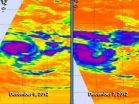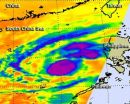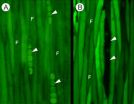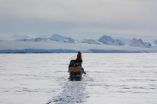(Press-News.org) SAN FRANCISCO (December 6, 2012) — In 2012, researchers at the California Academy of Sciences added 137 new relatives to our family tree, enriching our understanding of the complex web of life on Earth and strengthening our ability to make informed conservation decisions. The new species include 83 arthropods, 41 fishes, seven plants, four sea slugs, one reptile, and one amphibian. Specimens ranged from Eviota goby fishes housed in museum collections for more than 30 years (reported in the October 12 issue of Zootaxa), to Trogloraptor cave spiders collected just two years ago (reported in the August 17 issue of ZooKeys). The new species were described by more than a dozen Academy scientists along with several dozen international collaborators.
Proving that there are still plenty of places to explore and things to discover on Earth, the scientists made their finds over four continents and two oceans, ventured into remote caves and descended to the bottom of the sea, looked in their owns backyards (California) and on the other side of the world (China). Their results, published in 29 different scientific papers, help advance the Academy's research into two of the most important scientific questions of our time: "How did life evolve?" and "How will it persist?"
"The ongoing discovery of new species is an important function of systematics-based institutions like the California Academy of Sciences," said Dr. Terry Gosliner, Dean of Science and Research Collections at the Academy. "During these times, when we are facing the planet's sixth mass extinction, species may be disappearing before we have a chance to find and describe them. How can we know what to protect, if we don't know that it exists in the first place?"
Below are a few highlights among the 137 species described by the Academy this year. For a full list of species, including geographic information, visit www.calacademy.org/newsroom/releases/2012/new_species_list.php.
SMALL BUT NOT FORGOTTEN
Goby fishes of the genus Eviota are very small—less than an inch long. Because of their tiny size and cryptic habits, these fishes are seldom seen by divers, but they are abundant on some reefs and may form an important part of the food chain. Many species in this genus have yet to be described, but Academy research associate David Greenfield does his part every year to fill in the Eviota family tree. In the October 12 and 19 issues of the journal Zootaxa, Greenfield and his colleagues described E. notata and E. springeri from the Indian Ocean, and E. fallax from the Western Pacific. The Indian Ocean gobies were actually first collected in the 1960s and 1970s; they were housed in museum collections for decades before finally receiving recognition as new species this year.
A NEW FAMILY OF SPIDERS - WITH CLAWS
The forests of the Pacific Northwest are renowned for their unique and ancient animals and plants, such as coast redwoods, tailed frogs, mountain beavers—and now, a large, newly discovered spider. Trogloraptor (or "cave robber") is named for its cave home and spectacular, elongate claws. It is a spider so evolutionarily special that it represents not only a new genus and species, but also a new family (Trogloraptoridae). Even for the species-rich insects and arachnids, to discover a new, previously unknown family is rare—it's been more than 100 years since the description of an entirely new spider family from North America.
Trogloraptor hangs beneath rudimentary webs beneath cave ceilings. It is about four centimeters wide when its legs are extended—larger than the size of a half-dollar coin. Its extraordinary, raptorial claws suggest that it is a fierce, specialized predator, but its prey and attack behavior remain unknown.
A team of citizen scientists and arachnologists found these spiders living in caves in southwest Oregon.
Trogloraptor was not the only new cave spider discovered in 2012: in another study involving spelunking, Academy scientists and their colleagues described ten new spider species (Tayshaneta spp.) living in central Texas caves.
OUT OF AFRICA
The islands of Sao Tome and Principe, located in the Gulf of Guinea off Africa's west coast, host a number of plants, fungi, mammals, birds, reptiles, and amphibians found nowhere else on Earth. Since 2001, the Academy has embarked on several multidisciplinary expeditions to the islands in an effort to document their biodiversity and raise conservation awareness. A new species of gecko found only on Principe, Hemidactylus principensis, was described this year by Academy scientist Bob Drewes and his colleagues. For a long time, it was considered the same species as Hemidactylus greeffi from Sao Tome, but morphological and molecular work has resolved them as two distinct species, endemic to their respective islands. "This gecko is just one more example of the amazing degree of endemism on Sao Tome and Principe," said Drewes. "Habitat destruction is a growing threat to the species on these islands, and we want to make sure the nation's residents know what they have to lose before they make decisions that will impact their rich biological resources."
On the other side of Africa, a frog collected in 1930 and deposited in a museum collection finally received recognition as a new species. Arthroleptis kutogundua was described by Academy scientist David Blackburn from a single specimen collected from the Ngozi volcanic crater in southwest Tanzania. It is unknown whether the species still exists in this remote region.
THE JAGUAR SHARK LIVES...
The California Academy of Sciences sent its first scientific expedition to the Galapagos Islands in 1905 and has since organized dozens of return trips. As a result, the Academy is now home to the world's most comprehensive collection of scientific specimens from these famous islands. In 2012, Academy scientists and colleagues described a new species of Galapagos catshark (Bythaelurus giddingsi) collected from depths of 1,400 - 1,900 feet via submersible. It is approximately a foot long and has a chocolate-brown coloration with pale, irregularly distributed spots on its body. The authors chose "jaguar catshark" as the common name for the new species, partly because of its spotted pattern, and partly because it bears a striking resemblance to the mythical "Jaguar Shark" seen cruising the dark depths in The Life Aquatic, the Wes Anderson film for which the authors have a particular fondness.
A BOUNTY OF REEF FISHES
June marked the debut of Reef Fishes of the East Indies, a magnum opus that was several decades in the making. Co-authored by Academy research associate Mark Erdmann, this three-volume book set provides descriptions and color photographs of more than 2,500 reef fishes, including 25 new species. Its geographic coverage spans the South China Sea, Andaman Sea, and the Coral Triangle—the region between the Philippines, Borneo, and New Guinea that is regarded as a global center of biodiversity. With these books, the authors hope to inspire appreciation for the area's marine fauna and help guide governmental efforts for conservation.
### ABOUT THE CALIFORNIA ACADEMY OF SCIENCES
The Academy is an international center for scientific exploration and education and is at the forefront of efforts to understand two of the most important topics of our time: life and its sustainability. The Academy has a staff of over 50 professional educators and Ph.D.-level scientists, supported by more than 100 Research and Field Associates and over 300 Fellows. Its research strengths fall into three broad areas: California biodiversity, global hotspots, and ocean ecosystems. Visit research.calacademy.org.
137 new species described by California Academy of Sciences in 2012
From clawed spiders to deep-sea sharks, spanning 4 continents and 2 oceans, these discoveries add to the family tree of life on Earth
2012-12-08
ELSE PRESS RELEASES FROM THIS DATE:
Mayo Clinic IDs genes that predict whether trastuzumab will work for breast cancer patients
2012-12-08
SAN ANTONIO, Texas -- Adding the drug trastuzumab to chemotherapy prevents cancer recurrence and improves survival in a large number of women with early stage HER2-positive breast cancer. But trastuzumab does not stop tumors from returning in about 25 percent of patients — and oncologists haven't been able to identify these women before treatment. This situation may soon change, according to a Mayo Clinic study being presented at the 2012 CTRC-AACR San Antonio Breast Cancer Symposium.
VIDEO ALERT: Video of Dr. Perez is available on the Mayo Clinic News Network.
A team ...
New small molecule inhibitor could be a safe and first-line treatment for metastatic breast cancer
2012-12-08
SAN ANTONIO, TX (December 7, 2012)—Previous research has shown that a family of genes, proteins and enzymes called the uPA system (for urokinase plasminogen activator) plays an active role in different facets of cancer's biology, including tumor cell invasion, the spread of metastases, and the growth of a primary tumor.
Mesupron® is a new small molecule inhibitor, taken as a pill, that inhibits the uPA system. The results from a recent phase II clinical study suggest that the drug could be a safe and first-line treatment that extends progression-free survival for metastatic ...
Green scientists propose safety testing system for development of new chemicals
2012-12-08
PITTSBURGH—A group of scientists from North America and Europe, including Carnegie Mellon University's Terry Collins, has developed a five-tiered testing system that manufacturers can use to ensure that the chemicals and consumer products they produce are free of harmful endocrine disrupting chemicals like BPA or DDT. Their study, "Designing Endocrine Disruption Out of the Next Generation of Chemicals," will be published in the January 2013 issue of the Royal Society of Chemistry journal Green Chemistry, and is currently available online.
Endocrine disrupting chemicals, ...
Greenland ice sheet carries evidence of increased atmospheric acidity
2012-12-08
Research has shown a decrease in levels of the isotope nitrogen-15 in core samples from Greenland ice starting around the time of the Industrial Revolution. The decrease has been attributed to a corresponding increase in nitrates associated with the burning of fossil fuels.
However, new University of Washington research suggests that the decline in nitrogen-15 is more directly related to increased acidity in the atmosphere.
The increased acidity can be traced to sulfur dioxide, which in the atmosphere is transformed to sulfuric acid, said Lei Geng, a UW research ...
NASA casts infrared eye on Southern Indian Ocean's Tropical Cyclone Claudia
2012-12-08
The third tropical cyclone in the Southern Indian Ocean has been renamed Tropical Cyclone Claudia as NASA's Aqua satellite passed overhead.The AIRS instrument on Aqua captured infrared imagery of Claudia over two days that showed the western quadrant is most powerful part of the cyclone.
Aqua flew over Tropical Cyclone Claudia on Dec. 6 at 1959 UTC (2:59 p.m. EST/U.S.) and Dec. 7 at 0811 UTC (3:11 a.m. EST/U.S.). The Atmospheric Infrared Sounder (AIRS) instrument analyzes storms in infrared light, and revealed the temperatures of clouds and sea surface around the storm. ...
NASA infrared data shows Typhoon Bopha re-strengthened in South China Sea
2012-12-08
The deadly typhoon that caused almost 300 deaths in the southern Philippines is making a loop in the South China Sea, and infrared NASA satellite data indicated that Bopha re-intensified.
NASA's Aqua satellite passed over Bopha on Dec. 6 at 1811 UTC (1:11 p.m. EST, U.S.) and the Atmospheric Infrared Sounder (AIRS) instrument aboard captured an infrared look at the storm. The infrared data revealed where the coldest, highest cloud tops were. The coldest cloud tops indicate the strongest storms with the heaviest rain, and AIRS data revealed they surrounded the center of ...
2013 will be a good year, NJIT biz professor forecasts at Chicago Fed Board
2012-12-08
Economic growth will rise to 3 percent in 2013 and 2014, while unemployment will drop to 7.3 percent by December of 2013, NJIT Leir Research Professor William V. Rapp, PhD, http://www.njit.edu/news/experts/rapp.php, told economists and others last week at the annual outlook symposium, http://www.chicagofed.org/webpages/events/eos_series.cfm, sponsored by the Chicago Federal Reserve Bank.
The first Henry J. Leir Professor of International Trade and Business in the NJIT School of Management, Rapp was invited to participate in the annual event which draws the nation's ...
Another muscular dystrophy mystery solved; MU scientists inch closer to a therapy for patients
2012-12-08
COLUMBIA, Mo. -- Approximately 250,000 people in the United States suffer from muscular dystrophy, which occurs when damaged muscle tissue is replaced with fibrous, bony or fatty tissue and loses function. Three years ago, University of Missouri scientists found a molecular compound that is vital to curing the disease, but they didn't know how to make the compound bind to the muscle cells. In a new study, published in the Proceedings of the National Academies of Science, MU School of Medicine scientists Yi Lai and Dongsheng Duan have discovered the missing pieces to this ...
Long-distance solute transport in trees improved by intercellular pathways in living woody tissues
2012-12-08
As large organisms, trees face some remarkable challenges, particularly regarding long-distance transport and communication. In addition to moving water and nutrients from their roots to their leaves, they must also integrate cell-to-cell communication over large areas. Furthermore, in order to function as a single, cohesive organism they must be able to effectively and efficiently send vital substances—such as DNA regulating signals—long distances along a network of cells, sieve-tubes, and vessels.
But how effective is this cell-to-cell communication and how far can ...
Massive crevasses and bendable ice affect stability of Antarctic ice shelf, CU research team finds
2012-12-08
Gaping crevasses that penetrate upward from the bottom of the largest remaining ice shelf on the Antarctic Peninsula make it more susceptible to collapse, according to University of Colorado Boulder researchers who spent the last four Southern Hemisphere summers studying the massive floating sheet of ice that covers an area twice the size of Massachusetts.
But the scientists also found that ribbons running through the Larsen C Ice Shelf – made up of a mixture of ice types that, together, are more prone to bending than breaking – make the shelf more resilient than it otherwise ...
LAST 30 PRESS RELEASES:
Young adults commonly mix cannabis with nicotine and tobacco
Comprehensive review illuminates tau protein's dual nature in brain health, disease, and emerging psychiatric connections
Book prepares K-12 leaders for the next public health crisis
Storms in the Southern Ocean mitigates global warming
Seals on the move: Research reveals key data for offshore development and international ecology
Sports injuries sustained during your period might be more severe
World's first successful 2 Tbit/s free-space optical communication using small optical terminals mountable on satellites and HAPS
Can intimate relationships affect your heart? New study says ‘yes’
Scalable and healable gradient textiles for multi‑scenario radiative cooling via bicomponent blow spinning
Research shows informed traders never let a good climate crisis go to waste
Intelligent XGBoost framework enhances asphalt pavement skid resistance assessment
Dual-function biomaterials for postoperative osteosarcoma: Tumor suppression and bone regeneration
New framework reveals where transport emissions concentrate in Singapore
NTP-enhanced lattice oxygen activation in Ce-Co catalysts for low-temperature soot combustion
Synergistic interface engineering in Cu-Zn-Ce catalysts for efficient CO2 hydrogenation to methanol
COVID-19 leaves a lasting mark on the human brain
Scientists use ultrasound to soften and treat cancer tumors without damaging healthy tissue
Community swimming program for Black youth boosts skills, sense of belonging, study finds
Specific depressive symptoms in midlife linked to increased dementia risk
An ‘illuminating’ design sheds light on cholesterol
Who is more likely to get long COVID?
Study showcases resilience and rapid growth of “living rocks”
Naval Research Lab diver earns Office of Naval Research 2025 Sailor of the Year
New Mayo-led study establishes practical definition for rapidly progressive dementia
Fossil fuel industry’s “climate false solutions” reinforce its power and aggravate environmental injustice
Researchers reveal bias in a widely used measure of algorithm performance
Alcohol causes cancer. A study from IOCB Prague confirms damage to DNA and shows how cells defend against it
Hidden viruses in wastewater treatment may shape public health risks, study finds
Unlock the power of nature: how biomass can transform climate mitigation
Biochar reshapes hidden soil microbes that capture carbon dioxide in farmland
[Press-News.org] 137 new species described by California Academy of Sciences in 2012From clawed spiders to deep-sea sharks, spanning 4 continents and 2 oceans, these discoveries add to the family tree of life on Earth





